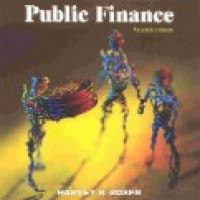
Public finance
| Gmd : Text
| Availability :
| 00000010023 | HJ257.2 .R67 2005 | (General Book) | Available - Ada |
Public Finance--while continuing to follow an innovative approach that is both theoretical and empirical--is now completely updated to reflect major changes in its key topics. New or revised information includes explanations of the Social Security trust fund, a new section on the alternative minimum tax (AMT), possible links between the corporation tax and high-profile scandals such as Enron, and more.
Part One: Introduction
1. Introduction: Public Finance and Ideology Government at a Glance
2.Tools of Positive Analysis:The Role of Theory Methods of
Empirical Analysis Concluding Remarks
3. Tools of Normative Analysis: Welfare Economics
The First Fundamental Theorem of Welfare Economics
Fairness and the Second Fundamental Theorem of Welfare Economics
Market Failure
Buying into Welfare Economics
Part Two: Analysis of Public Expenditure
4. Public Goods: Public Goods Defined
Efficient Provision of Public Goods
The Privatization Debate
Education
Public Goods and Public Choice
5. Externalities:
The Nature of Externalities
Graphical Analysis
Private Responses
Public Responses to Externalities
The US Response
Implications for Income Distribution
Positive Externalities
6. Political Economy:
Direct Democracy
Representative Democracy
Explaining Government Growth
7. Income Redistribution, Conceptual Issues:
Distribution of Income
Rationales for Income Redistribution
Expenditure Incidence
8. Expenditure Programs for the Poor:
A Quick Look at Welfare Spending
Institutional Setting
Issues in the Design of Welfare Programs
The Earned Income Tax Credit
Supplemental Security Income
Medicaid
Food Stamps and Child Nutrition
Housing Assistance
Programs to Enhance Earnings
9. Social Insurance I: Social Security and Unemployment Insurance: Why Have Social Insurance?
Structure of Social Security
Effects on Economic Behavior
Long-Term Stresses on Social Security
Social Security Reform
Unemployment Insurance
Conclusions
10. Social Insurance II: Health Care:
What?s Special About Health Care?
The US Health Care Market
The Role of Government
The Twin Issues: Access and Cost
Should Government?s Role in Health Care Increase?
11. Cost-Benefit Analysis:Present Value
Private Sector Project Evaluation
Discount Rate for Government Projects
Valuing Public Benefits and Costs
Games Cost?Benefit Analysts Play
Distributional Considerations
Uncertainty
An Application: Are Reductions in Class Size Worth It?
Use (and Nonuse) by Government
Part Three: A Framework for Tax Analysis
12.Taxation and Income Distribution:
Tax Incidence: General Remarks
Partial Equilibrium Models
General Equilibrium Models
Conclusions
13.Taxation and Efficiency:
Excess Burden Defined
Excess Burden Measurement with Demand Curves
Differential Taxation of Inputs
Does Efficient Taxation Matter?
14.Efficient and Equitable Taxation:
Optimal Commodity Taxation
Optimal User Fees
Optimal Income Taxation
Politics and the Time Inconsistency Problem
Other Criteria for Tax Design
Part Four: The United States Revenue System
15.The Personal Income Tax:
Basic Structure
Defining Income
Excludable Forms of Money Income
Exemptions and Deductions
Rate Structure
Choice of Unit and the Marriage Tax
Taxes and Inflation
Treatment of International Income
State Income Taxes
Politics and Tax Reform
16.Personal Taxation and Behavior:
Labor Supply
Saving
Housing Decisions
Portfolio Composition
A Note on Politics and Elasticities
17.The Corporation Tax:
Why Tax Corporations?
Structure
Incidence and Excess Burden
Effects on Behavior
State Corporation Taxes
Taxation of Multinational Corporations
Corporation Tax Reform
18.Deficit Finance:
How Big Is the Debt?
The Burden of the Debt
To Tax or to Borrow?
19.Taxes on Consumption and Wealth:
Retail Sales Tax
Value-Added Tax
Hall-Rabushka Flat Tax
Cash-Flow Tax
Efficiency and Fairness of Personal Consumption Taxes
Income versus Consumption Taxation
Wealth Taxes
Estate and Gift Taxes
Part Five: Multigovernment Public Finance
20.Public Finance in a Federal System:
Background
Community Formation
The Tiebout Model
Optimal Federalism
Property Tax
Intergovernmental Grants
Appendix: Some Basic Microeconomics
| Series Title |
-
|
|---|---|
| Call Number |
HJ257.2 .R67 2005
|
| Publisher Place | Boston |
| Collation |
xxx, 609 p. : ill. ; 24 cm
|
| Language |
English
|
| ISBN/ISSN |
0071238425
|
| Classification |
HJ210-1620
|
| Media Type |
-
|
|---|---|
| Carrier Type |
-
|
| Edition |
7th ed.
|
| Subject(s) | |
| Specific Info |
-
|
| Statement |
-
|
| Content Type |
-
|
No other version available







